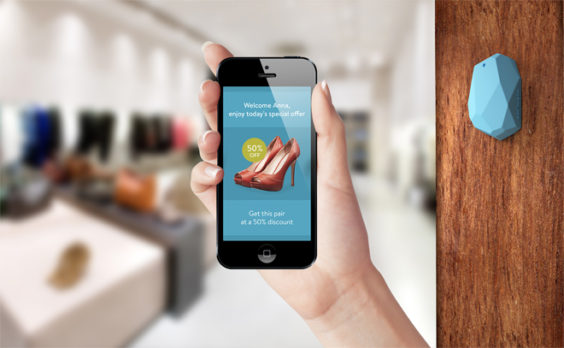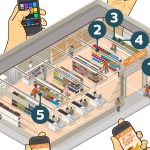Could 2016 be the year of the beacon?
Much has been made of the promise of coupons that find you, instead of waiting for you to find them. The technology has been touted as a game-changer since it emerged a couple of years ago, but it’s far from fully realized.
That could change, though, this year and in the years to come.
A study from Juniper Research predicts that nearly 1.6 billion coupons will be delivered via beacon technology in 2020, up from just 11 million in 2015. If you do the math, that’s an increase of 16,000% in five years.
Beacons are low-powered Bluetooth transmitters that can communicate with your phone when you get nearby. If you’ve ever gotten a notification from a shopping app when you approach a store – that’s beacon technology.
But beacons can do more than just alert you to generic deals when you walk into a store. They can deliver specific coupons to you, based on precisely where you are in the store. Your phone might receive a mobile coupon for ice cream, when you walk down your grocery store’s frozen food aisle. You might get a coupon for peanut butter, when you linger by the jelly.
There are plenty of possibilities, but few who have taken full advantage of the technology yet. With that predicted 16,000% increase just a few years away, though, Juniper says it’s about to get very big, very fast. “While rollout has been perhaps slower than was originally envisaged, a number of leading retailers have now begun to deploy beacons in their stores and outlets,” the report reads.
Department stores were among the first to go all in on beacons, with retailers like Macy’s and Lord & Taylor installing transmitters in all of their stores. Several other retailers are dipping their toes in the water, testing out beacons in a handful of locations. Target is among them, with beacons now operational in 50 test stores across the country.
“Brands have recognized that coupons with a location element typically enjoy far higher redemption rates than those without, particularly in the form of impulse purchases,” the Juniper report reads.
But there are challenges that could stand in the way of Juniper’s bold prediction. For instance – do you really want 1.6 billion coupons sent to your phone while you shop?
“Many retailers (are) concerned that excessive, indiscriminate messages ‘pushed’ by the beacon could be perceived as intrusive and damage their relationship with the customer,” Juniper researchers say. If stores are constantly pinging your phone with offers, beacons could quickly transform from a promising couponing platform, into a nag.
Plus, you need to have the right app downloaded, and open, in order to receive coupons and offers at all. There are only so many retail apps you can have on your phone – you’re certainly not going to have one for every store you visit. Target delivers coupons via its own app, but Macy’s and Lord & Taylor rely on more popular third-party apps like Shopkick and SnipSnap to deliver their coupon notifications.
The drawbacks have prompted some skeptics to say that any predictions about the “year of the beacon” – or a 16,000% increase in beacon-delivered coupons – are off base. “Target’s beacon strategy, like Macy’s and others, is doomed to fail,” retail analyst Gene Marks wrote on Forbes.com last summer. Shoppers want to be informed, he argues, not marketed to. “For beacon technology to succeed, it should say to the customer: ‘Hey, I’m here if you need me,’ not ‘Welcome back… now buy this product’.”
Privacy is also a potential sticking point. In order to receive coupons via beacon, you have to opt in and give retailers permission to track you as you walk through their store. That could prompt many shoppers to opt out of beacons altogether.
“Retail is an industry of fads,” Bloomberg Business declared last November. “It has yet to be proven that beacons will be anything more than one of them.”
So whether Target expands its test, other retailers join in, or Juniper’s prediction pans out – we’ll find out, in the coming years. In the meantime, better keep your phone handy – just in case.
Image source: Estimote












